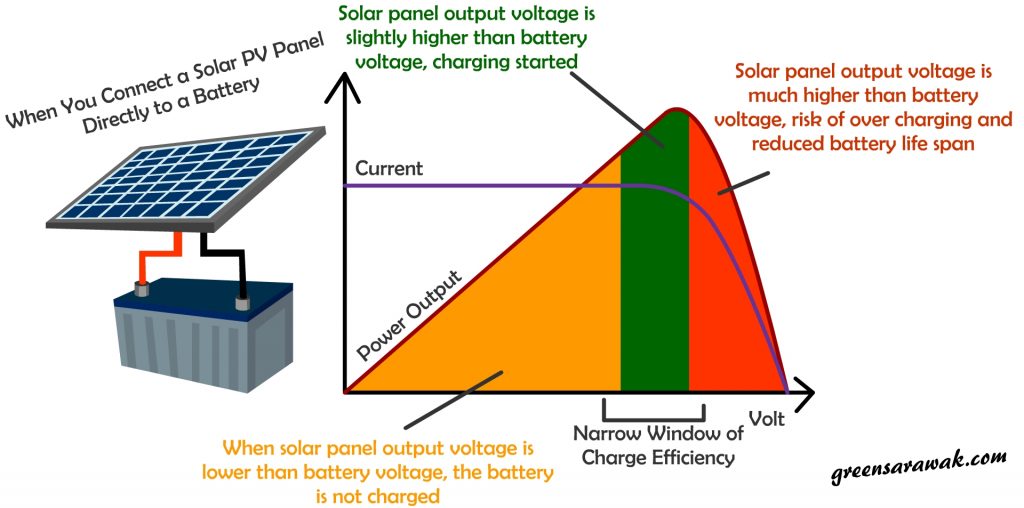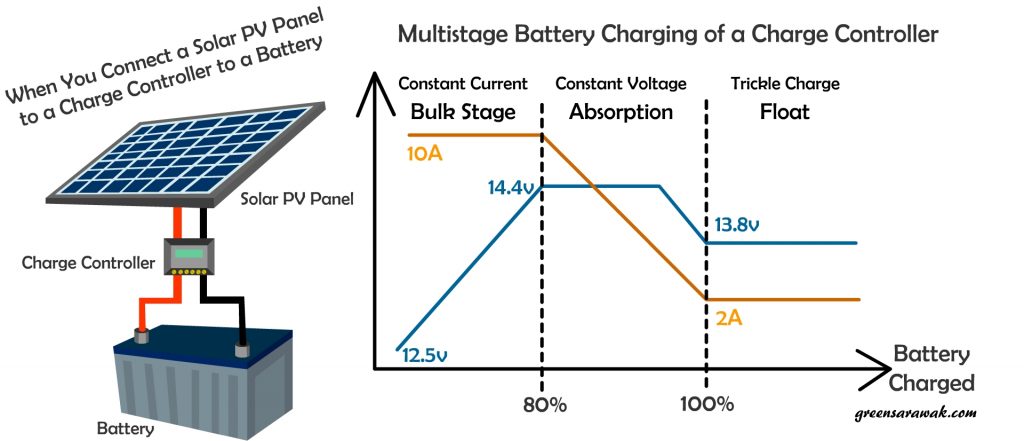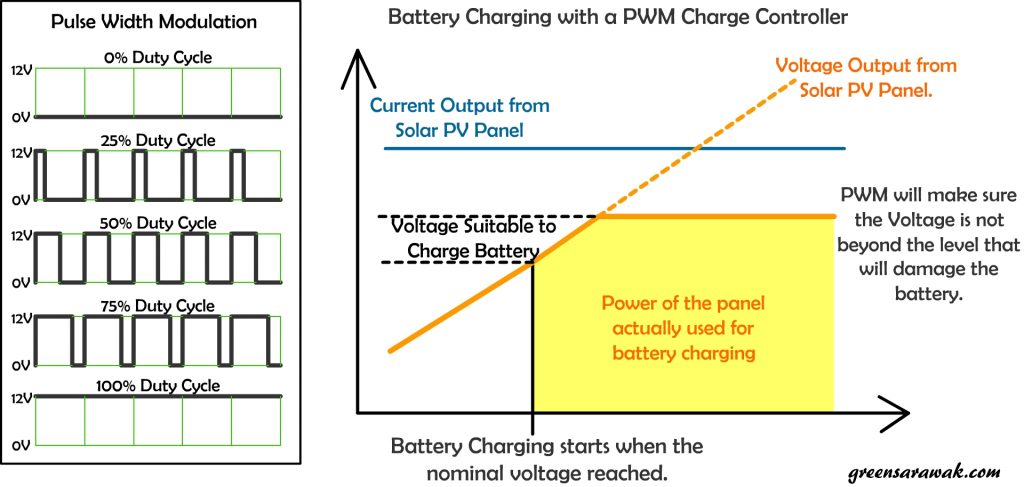Using Solar PV without a charge controller
It is possible to charge your battery directly from a solar PV panel. As long as the power generated by the solar panel is greater than the battery, it will have a net flow of energy to charge your batteries. In the end the battery is still get charged. However, you won’t get a full efficient system running without a charge controller.
Following issues exist if you connect a solar PV panel directly to a battery.
- A typical solar panel will output 16 volts to 18 volts under sunlight (with some can goes into >20 volt at maximum power), depends irradiance and temperature of solar panel, the voltage can be widely varies throughout the day. The battery (commonly used 12 volts) have a limited effective charging voltage, usually 12-14 volts. With extra voltage running into the battery will actually cause more damage to the battery via over voltage and over charging and it reduce the lifespan of the battery.
- Without a charge controller acting as a middle man between the solar PV panel and the battery, during low irradiance or at night, the battery power may leak back to the solar PV panels, causing loss of energy.
- Without a charge controller, battery charge state connected the load is not monitored, hence having risk of fully discharge a battery that damages the battery in the long run. Charge controller usually will switch off the power to the load automatically to prevent further discharge a battery with low charge state (low voltage).

Solar Charge Controller
Hence a solar charge controller have the function to control the charging of the battery, prevent overcharging, and prolong lifespan of the battery. Charge controllers can detect the state of the battery and decide to charge if the battery level is low, stop charging if the battery level is full and stop the load from using the battery power when the battery voltage is very low with risk of full discharge. Other function such as float charging can keep battery always at full charge stage.

From the voltage of the battery , the charge controller can decide the charging stage of the battery and deliver the corresponding voltage and current to charge the battery. When using a charge controller with a Flooded Battery, AGM Battery and Seal Lead Acid Battery, the charge controller can generally decide one of the three stage of charging – Bulk Stage (Constant Current), Absorption Stage (Constant Voltage) and Float Stage (Trickle Charging).
The first stage contribute to the majority of the charge to the battery until the battery voltage reaches 14.4V, which corresponding nearly 80% charged battery. Another variant known as Boost charging where high current is delivered during the initial period of charging a heavily discharged battery.
Once reaching charge state of >80%, the charging will be slow down to prevent overheating and damage to the battery. The current is slowly limited while voltage is constant. Once battery is near 100% charge, it will goes into a Float stage where a constant current and voltage of around 13.8V to safely maintain battery at 100% charge (as battery can naturally discharge over time).
The two most common type of charge controller is PWM (Pulse Width Modulation) and MPPT (Maximum Power Point Tracking). This two type of solar charge controller differs by method to handle the power input from the solar panel.
Using Solar PV with a PWM charge controller
PWM is cheaper than MPPT charge controller. It is much simple to build, easy to mass produce and fundamentally a charge controller with a switching capability. Similar to PWM used in motor speed controller and switching power supplies in computers and mobile, the concept is using a very high frequency controlled switching, it creates a variable pulse of on and offs with variable timing. Its function is to reduce the voltage and power from the input to the output.

PWM have very high efficiency if the input is rather stable. However solar panels don’t produce a stable output, they varies according to sunlight condition and panel temperature.
The main concern is the Solar Panel – Battery mismatch. A 12V nominal systems would work best with a solar panel voltage of 17-19V (considering other factors that can cause voltage drop while transferring energy from the PV cells to the charge controller, including heat and wire resistant) . Voltage that is much beyond will be less useful.
At very low irradiance (thick cloud, raining, dusk, dawn, and night) and very high panel temperature (solar PV panels under hot sunlight of the summer will have voltage drop due to typical silicon solar panels have a temperature coefficient of about -0.4 to -0.5 percent for every degree above 25 Celsius), the voltage will be lower than the nominal charging voltage of the battery. The PWM will stop charging the battery and losing allot of potential charging opportunity.
Furthermore in PWM system you can’t have too many panels in series (as putting panels in series will generate high voltage which is not easily match with a battery via a PWM) and you need an expensive bigger gauge wire or short panel to battery distance due to handling of larger amperage to transfer the same energy.

Hence there comes a more advance MPPT solar charge controller. This is a more expensive, huge and complex charge controller which is easily scale according to your project needs.
Using Solar PV with a MPPT charge controller
A Maximum Power Point Tracking charge controller is a charge controller with a integrated circuit micro controller “brain” coupled with a high frequency high efficiency DC to DC converter. The micro controller takes real time voltage reading from the solar PV panel and the battery (via electronic tracking), then using a algorithm to figure out the best power the solar PV panel can used to match and charge the battery.
It involves converting the Direct Current produced by the solar PV panels into high frequency Alternating Current around 20-80kHz, then convert it back to different DC voltage that match the battery. Most modern MPPT’s are around 93-97% efficient in the conversion.

If the receiving voltage from the solar PV panel is high, it can convert it to lower voltage with higher amperage that match the charging battery. If the receiving voltage from the solar PV panel is lower than the battery voltage, it can up convert to higher voltage with lower amperage to charge the battery. Hence you will still have a solar PV System that can still charge the battery even in low sunlight or in winter.
With MPPT you can easily expand your Solar PV Panel array, putting them in series to produce high voltage (usually MMPT can support up to 150V DC, or some advance unit up to 600V DC) and low amperage output, which reduce the current loss via heat dissipation (higher ampere will have less efficiency due to energy loss as heat during transfers). With less amperage, you can place your panels far from the batteries. But be extra careful when handling such system as high voltage can cause significant risk of electric shock if handled improperly.
To decide upon a MPPT or PWM, the most important is still cost. MPPT is 3-5 times more expensive than a PWM charge controller. You typically get a 20 to 45% power gain in winter and 10-15% in summer if you use MPPT charge controller instead of PWM.
If you which to get the most power efficiency out of your panels, MPPT is a good choice. It will squeeze the last ounce of juice from your panels in unfavorable low sunlight conditions, such as winter and places with lots of clouds.
If you want to simple solar system for a simple garden light system, PWM might be enough to meet your need.
With dropping cost of Solar PV cells, sometimes it is cheaper to increase the size or number of the solar cells (if size of solar PV panels is not a concern) instead of investing on expensive MPPT charge controller.
NEXT CHAPTER >> Know Your Battery
